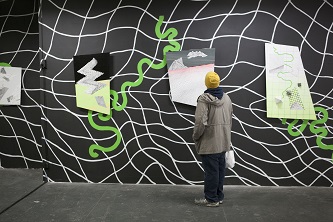M.F.A. Art Students Display Dazzling ‘Thru-Line’ at New York’s Moynihan Station
May 19, 2016
The art of 14 students from Brooklyn College’s M.F.A. in Art Program was on display at New York’s Moynihan Station from May 5¬ to May 10 as part of the college’s annual M.F.A. Thesis Exhibition. Thru-Line used a wide variety of art forms—including ceramics, drawings, fibers, painting, photography, sculpture, video, and mixed media—to raise questions about culture, identity, memory, place, and politics.
“I was part of the planning committee for exhibition so I and my fellow committee members learned a lot about the ins and outs of putting on a large-scale exhibition here in New York,” says M.F.A. art student in drawing and painting, Tegan M. Brozyna, who has showcased previously at the Philadelphia International Airport. “We got to know a number of galleries and art professionals, and we also learned the process for applying for spaces and permits. It was a tough, but good learning experience.” Moynihan Station (formerly Farley Post Office) currently is being transformed into a civic space that helps to cultivate art and culture through the advocacy of the Municipal Art Society of New York.
“I think getting the art ready for the show—packaging it up, moving it, loading and unloading and figuring out how to store it—was definitely the missing piece in terms of my skill set before grad school,” says Debbi Kenote, an M.F.A. art in sculpture student. “If you want to show your work in New York City, you have to be clever about the storage and movement of the work.”
All M.F.A. art students must participate in thesis exhibition to fulfill the program’s degree requirements.
“Additionally, it gives the students and their work exposure,” says Assistant Professor Doug Schwab, director of graduate studies for the M.F.A. Art Program. “Faculty members come to the opening night of the show and they invite guests. Family and friends of the students attend. And other people who have read about the show in the various the media in which it is publicized [attend].”

Tegan M. Broznya hammers away at her exhibition piece, waiting for it all to come together.

“My work reflects a need to find and cultivate peace in a world clamoring with noise and weighted by violence and pain.” – Tegan M. Brozyna

Debbi Kenote lets the sparks fly as her art begins to take shape.

“My work explores incongruities in Western ideals of youth, utopia, and liberty.” – Debbi Kenote

“I want to examine the place of the body in relation to the psyche.” – Melissa Capasso

“My work aims to facilitate honest conversations regarding race, alienation, and assimilation.” – Valery Estabrook

“My portraits explore representations of power, identity and confrontation.” – Dianne Hebbert

“There is a mystery in painting I am training myself to see.” – Javan Grover

“My work explores the various connections, exchanges, and interactions that occur within human relationships.” – AnneMarie Graham

“The pieces continually [mine] the visual expressions of accumulated excess.” – Alyssa McClenaghan

“My work addresses the question of how I can appropriate personal emotions into a shared language.” – Angela Kim

“I want to question what photography actually is and how it influences the way I understand my own experiences and memories.” – Francesca Simonite

“My art-making practice is an attempt to hold on to places that resonate with particular meaning in my mind.” – Steven Naukam

“I am interested in things that fold, roll, unroll, transform, and collapse, including scrolls, books, costumes, temporary structures, awkward events, and revolutionary struggle.” – Abigail S. Miller

“The work that I am creating is an investigation into an alternate universe or dimension of my own construction.” – Charles Sommer

“I strive to bring as closely together the experience of making the piece to that of viewing it.” – Michael Uttaro
Schwab adds that the program provides students with valuable experience they need to turn their artistic skills into marketable talents.
“What our students experience in the program that is of most value is faculty guidance,” he says. “Expert opinions encompass ways in which to apply technique in order to achieve goals, or it could be helping them produce the work to which they are best suited.”
For the students themselves, the program not only helped them hone their skills, but it also helped them to confront and overcome the fear that many students experience when pursuing their dreams: how to survive financially while pursuing their artistic purposes.
“If you choose to pursue a career in art then know that you need to put in a lot of hard work,” Brozyna says. “You will make certain sacrifices, often financial. You have to learn to run a marathon not a sprint, and you need to stay determined.”
Both students agreed that choosing to enroll in the Brooklyn College M.F.A. Program, rather than more expensive programs at other schools lessened their financial burdens.
“I gained a lot of hands-on experience as well,” says Kenote. “There is also nothing like going to school in New York City. You are learning about and making history simultaneously.”
Broznya and Kenote both plan to set up their own art studios in the near future.







